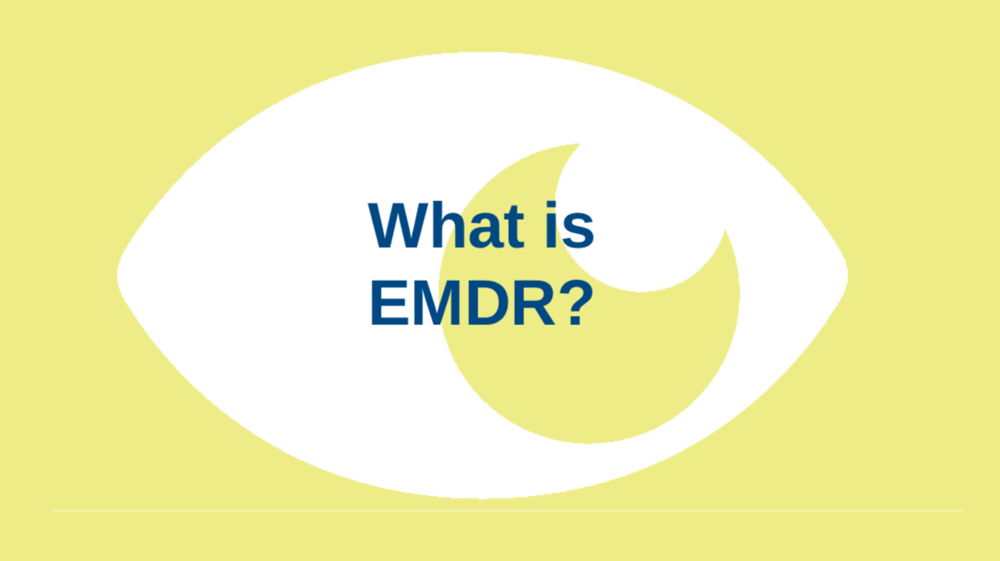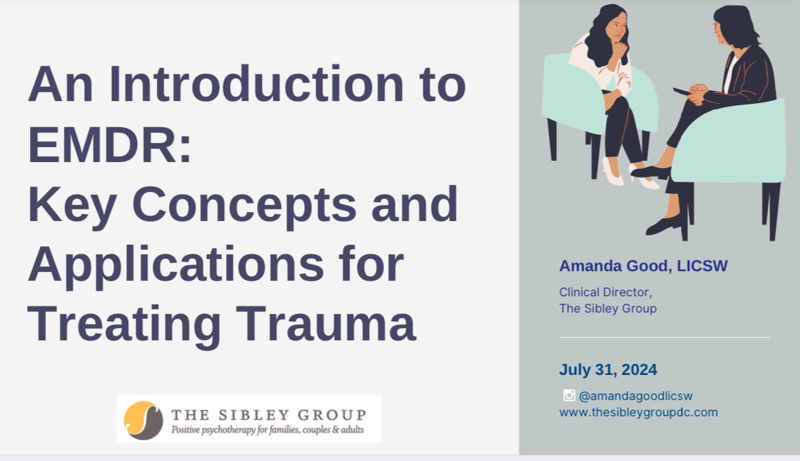
-
course Info -
Content -
Ce Approvals
An Introduction to EMDR: Key Concepts and Applications for Treating Trauma
Learning Objectives
Explain the AIP Model for understanding trauma. State the 8 phases of EMDR. Identify different client populations and presenting symptoms that would benefit from EMDR.
Learning Levels
Beginner
Target Audience
Course Instructor(s)
-
 Amanda GoodClinical Director, The Sibley Group
Amanda GoodClinical Director, The Sibley GroupAmanda Good, LICSW, EMDR-C, is the Clinical Director at The Sibley Group in Washington DC, where she has been a psychotherapist for adolescent and adult clients for 15 years. She specializes in treating stress, anxiety, and trauma related symptoms, and is certified in Eye Movement and Desensitization Therapy (EMDR).
Amanda writes, teaches, and consults on a variety of topics relating to trauma treatment, and is passionate about making mental health concepts and treatment easily understandable for clinicians and clients alike. Using a blend of evidence-based treatments including EMDR, IFS, EFFT, CBT, and DBT, as well as a deeply grounded and relational approach, Amanda provides therapy and teaches therapists to go beyond symptom management to healing root problems and achieving lasting change.
References
McGowan, I. W., Fisher, N., Havens, J., & Proudlock, S. (2021). An evaluation of eye movement desensitization and reprocessing therapy delivered remotely during the Covid–19 pandemic. BMC psychiatry, 21, 1-8. DOI: https://doi.org/10.1186/s12888-021-03571-x Hase, M. (2021). The structure of EMDR therapy: A guide for the therapist. Frontiers in psychology, 12, 660753. DOI: https://doi.org/10.3389/fpsyg.2021.660753 Knipe, J. (2019). EMDR toolbox : theory and treatment of complex PTSD and dissociation -- Eye movement desensitization reprocessing toolbox (2nd ed.). New York: Springer Publishing Company. Shapiro, F. (2018). Eye Movement Desensitization and Reprocessing Therapy: Basic Principles, Protocols, and Procedures (3rd ed.). New York, NY: The Guilford Press De Jongh, A., Amann, B., Hofmann, A., Farrell, D., & Lee, C. (2019). The Status of EMDR Therapy in the Treatment of Posttraumatic Stress Disorder 30 Years After Its Introduction. Journal of EMDR Practice and Research (13), 261-269. Maxfield, L. (2019). A clinician’s guide to the efficacy of EMDR therapy. Journal of EMDR Practice and Research, 13(4), 239–246. Laliotis, D., Luber, M., Oren, U., Shapiro, E., Ichii, M., Hase, M., La Rosa, L., Alter-Reid, K., & Tortes St. Jammes, J. (2021). What is EMDR Therapy? Past, Present, and Future Directions. Journal of EMDR Practice and Research, 15(4), 186-201. DOI: 10.1891/EMDR-D-21-00029 Van der Kolk, B.A., Spinazzola, J., Blaustein, M.E., Hopper, J.W., Hopper, E.K., Korn, D. L., & Simpson, W.B. (2007). A randomized clinical trial of eye movement desensitization and reprocessing (EMDR), fluoxetine, and pill placebo in the treatment of posttraumatic stress disorder: treatment effects and long-term maintenance. Journal of Clinical Psychiatry, 68(1), 37-46.
CE Process Info
Content
-
Recorded Webinar: An Introduction to EMDR1 parts
-
Recorded Webinar: Introduction to EMDR
-
-
Powerpoint Slides1 parts
-
An Introduction to EMDR: Powerpoint Slides
-
-
New York State Education Department's State Board for Social Work (NYSEDSW)
CE Learning Systems SW CPE is recognized by the New York State Education Department's State Board for Social Work as an approved provider of continuing education for licensed social workers #0060.
-
New York Education Department for Licensed Mental Health Counselors (NYSEDLMHC)
CE Learning Systems, LLC is recognized by the New York State Education Department's State Board for Mental Health Practitioners as an approved provider of continuing education for licensed mental health counselors. #MHC-0072.
-
New York State Education Department's State Board for Psychology (NYSEDPSY)
CE Learning Systems dba CE-Credit.com & AddictionCounselorCE.com is recognized by the New York State Education Department's State Board for Psychology as an approved provider of continuing education for licensed psychologists #PSY-0016.
-
New York State Education Department's State Board for Marriage and Family Therapy (NYSEDMFT)
CE Learning Systems dba CE-Credit.com & AddictionCounselorCE.com is recognized by the New York State Education Department's State Board for Marriage and Family Therapy as an approved provider of continuing education for licensed marriage and family therapists #MFT-0045.
-
Joint Accreditation (JA)
In support of improving patient care, CE Learning Systems is jointly accredited by the Accreditation Council for Continuing Medical Education (ACCME), the Accreditation Council for Pharmacy Education (ACPE), and the American Nurses Credentialing Center (ANCC), to provide continuing education for the healthcare team.
-
American Psychological Association (APA)
Continuing Education (CE) credits for psychologists are provided through the co-sponsorship of the American Psychological Association (APA) Office of Continuing Education in Psychology (CEP). The APA CEP office maintains responsibility for the content of the programs.

-
CE Hours 3 -
Type Self-Paced -
Publication Date Aug 15th, 2024 -
Expires on August 31st, 2025
Reset password
We sent a reset password link to the email address you provided.
{{reset.email}}
If you do not see the email, try checking your junk or spam folder.
If you don't receive a link in the email you provided, please click the button below to resend the
verification email.
Please wait {{timer}} seconds to resend
Sign in
Sign in
Thanks for signing up!
We sent an verification email to the address you provided. Please check your email to verify your email address.
{{signup.email}}
If you do not see the email, try checking your junk or spam folder.
If you don't receive a link in the email you provided, please click the button below to resend the verification email.
Please wait {{timer}} seconds to resend
Sign up
Shopping Cart
-
{{ item.name }} ({{ item.courses.length }} courses)
{{ item.credit_hours }} Credits
{{ item.coupons.map((c)=> c.code).join(', ') }}${{ item.totals.price }}${{ item.totals.total_price }}
Cart is empty
Thank you for your purchase
To access the course content, click the button below. Enrolled courses may be accessed at any time by going to your Account and clicking Courses
